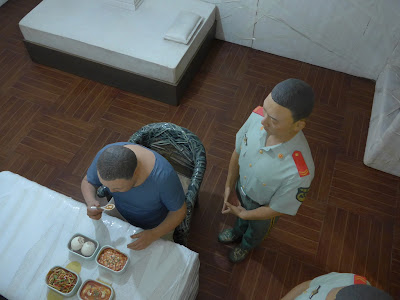It was another of those precious days. A week-day when you both have a day off. The youngest two kids on the train to Granny's house and the older two probably spending the day in bed, it was half term. We had a day off together in early January too, and we went to the Hunterian Museum which you can read about here. This time we were off to see Ai WeiWei at the Royal Academy.
This was my choice, I was keen, my husband knew absolutely nothing about Ai WeiWei; his artwork and outspoken criticism of the Chinese government, for which he has been arrested, imprisoned and beaten.
When you arrive you are met in the courtyard by trees. Branches of dead trees are bolted together to look like whole trees. Industrial bolts hold the branches together, looking precariously balanced, a little top heavy. This is the first piece of Ai WeiWei's work to capture my husband's imagination. Mine too, but more for the strange beauty than the engineering.
Balance and engineering run through Ai WeiWei's work.
However you can clearly see that it isn't possible to balance between these parallel bars anymore. They have been filled with wood reclaimed from Qing Dynasty temples which were flattened for the sake of modernisation, to make way for new buildings in developing cities.
As an engineer, my husband knows exactly what these are. Steel bars used to reinforce concrete. All that engineering training yet he never thought he would see them a source of contemplation.
Each bar was purchased as twisted and bent scrap metal following the collapse of 20 schools and colleges during a powerful earthquake in 2008. Shoddy workmanship and materials were blamed for the deaths of over 5,000 students, kids. In their memory 200 tonnes of steel bars have been painstakingly straightened.
Ai WeiWei, with others, established a 'citizens' investigation', a campaign to record all the names of these kids. Thousands of students with their dates of birth are numbered and listed on the Royal Academy walls. We feel uncomfortable, challenged and truly sad.
In 2010 in the name of regeneration, the authorities invited Ai WeiWei to build a new studio, which as soon as it was completed, they ordered him to demolish under the pretext that he had not got planning permission. Ai WeiWei managed to procure some of the original building materials during the demolition to create yet more work.
To commemorate the building of this studio and its imminent demolition, Ai WeiWei held a party, putting an open invitation on the Internet. 800 guests came to feast on river crabs, a feast to which Ai WeiWei could not be present as by then he had been placed under house arrest.
Whilst incarcerated, although forbidden to discuss anything from the 81 days, he memorised every detail of his cell and has since created six scenes from his time in there, six boxes in which he tells his story, all half actual size. To see inside you have to look through small hatches in the walls and ceilings. That kind of changes your position, from looking at a piece of work in a gallery to feeling like a voyeur. Asking what on earth should I be doing about this?
I like the way Ai WeiWei challenges the value of stuff, painting these neolithic and 1st century Dynasty vases with industrial paint. He then has photographs of himself taken, dropping one to the floor. You kinda get that, and are challenged to think about whether some things are worth the price. Nothing, however valuable, could replace the lives lost in that earthquake.
Ai WeiWei is a communicator. He has things to say. He speaks through making and his voice is heard all over the world via social media. He has a huge international following on on Twitter and Instagram.
Back to the question, what on earth should I be doing about this? Not a direct answer but I have been so encouraged by this story. I don't have a photo but around the doors of the exhibition entrance, the walls are papered with wallpaper made up of I.O.U notes from Ai WeiWei to the people who came forward with money to help him pay a bill. Straight after his 81 day incarceration, Ai WeiWei's company was charged with tax evasion, fined £1.5 million and given 15 days to pay. At this point 30,000 people stepped up to help, some even throwing money over his studio walls.
Ai WeiWei's exhibition at the Royal Academy runs until 13th December 2015. Check out the Royal Academy website here.
Ai WeiWei communicates globally through social media, ironically the social aspect of our day out was slightly curtailed by the audio-tour (which was brilliant). The audio-tour, took us to the places above, to those places which inspired Ai WeiWei to make art, going there alone on a day out together.
























































